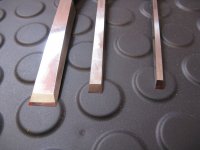This thread confirms one thing that many of us already know: there is no single perfect honing guide out there including the free hand method that can meet all the sharpening needs. (Try free hand sharpening a skew rabbet plane blade, and one will know how slow it is as compared to using a Veritas MKII jig with the skew registration guide. If your skew angle is off, you will have issues setting the blade to make proper cuts).
If there were, WP's latest jig would not have been coming out. The best one, I suspect, is a combination of different systems (including free hand methods and a power sharpening system (for speed)) that address each individual woodworker's varying needs.
I free hand sharpen regular chisels and plane blades, but use a jig for skew blades, back bevels, mortising chisels and the narrowest chisel (1/16"). I turn to a grinder to reestablish bevels or remove nicks on edges when needed (which could take a long time to do on a stone, and also wear out the stone).
The requirement to use a screwdriver (for the WP's and L-N's) is indeed a nuisance, but not a deal killer, because you can sort your tools into groups, and finish one group first before changing the wheels or jaws. This is no different from using the domino joiner cutting all the mortises with one width setting (e.g. standard) before switching the dial to the wider setting.
Anyone who wants a jig that is most price competitive should consider this:
I used the modified side-clamping jig (there are other videos out there showing you how to fix the Eclipse) before saving enough change for the MKII guide.

